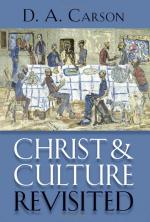 D. A. Carson’s recent contribution to the growing, informed discussion regarding Christ & Culture is a worthy read. However, Christ and Culture Revisited is not without its shortcomings. In a series of posts, I offer a critical reading of Carson’s well-researched book in an attempt to further good thinking and practice on the topic of Christ & Culture.
D. A. Carson’s recent contribution to the growing, informed discussion regarding Christ & Culture is a worthy read. However, Christ and Culture Revisited is not without its shortcomings. In a series of posts, I offer a critical reading of Carson’s well-researched book in an attempt to further good thinking and practice on the topic of Christ & Culture.
Author: Jonathan Dodson
How Far Does Salvation Extend?
 Continuing the Prologue to MissionSHIFT, Ed Stetzer raises some important questions about the scope and focus of salvation. He writes:
Continuing the Prologue to MissionSHIFT, Ed Stetzer raises some important questions about the scope and focus of salvation. He writes:
Should the definition of “salvation” be expanded beyond personal redemption of sins to include social justice through the reformation of economic and political institutions? We are not debating here whether we think social justice is right or wrong but rather should it be included in what we mean we we talk about “salvation.” Evangelicals have generally said no and mainliners have generally said yes.
Another way to ask this question is:
Are social justice, political reform, cultural renewal implications of the Gospel or actually part of the Gospel?
What do you think? What does the Bible teach on this?
——————–
Others participating in the conversation:
Ed Stetzer
Rick Meigs: The Blind Beggar
Bill Kinnon: kinnon.tv
Brother Maynard: Subversive Influence
David Fitch: Reclaiming the Mission
Tiffany Smith: Missional Mayhem
Jared Wilson: The Gospel-Driven Church
Viral Hope: Coming Soon!
Viral Hope: Good News from the Urbs and the Burbs (and everything in between)
“ViralHope is a bold call to reject any and all reductions of the Gospel that minimize it to ‘cosmic fire insurance’ on the one hand, or on the other, to reduce it to ‘social action.’ This is a full Gospel and a vision that our world desperately needs to hear.”
– Jim Belcher, Deep Church: A Third Way Beyond Emergent and Traditional Church
5 Ways to Fail My Church
 Reading through the Pastoral letters of the New Testament, I’ve been struck by the fact that if I don’t insist on Gospel-centered doctrine in my church, then I will fail you in at least five ways. If I don’t insist on Gospel-centered doctrine, then…
Reading through the Pastoral letters of the New Testament, I’ve been struck by the fact that if I don’t insist on Gospel-centered doctrine in my church, then I will fail you in at least five ways. If I don’t insist on Gospel-centered doctrine, then…
- The church will devolve into a socially-minded non-profit or a consumeristic Groupon. The gospel of Jesus Christ is what sets the church apart from any other organization or community. If I remove the gospel, or don’t insist on its centrality in everything we do, then you do not need the church. You can find social service outlets with better non-profits and community with Groupon gatherings.
- You will lose a substantial reason for living in community and on mission. Though anyone can experience community and mission outside of the church, it is a gospel-centered church that keeps mission and community from becoming your raison d’etre (reason for being). If community becomes your reason for being, then your community will likely become ingrown, selfish, snobbish, cliquish NOT inclusive, diverse, generous, growing, and vibrant. If mission is your raison d’etre, they mission will eventually become optional or so essential that you will look down on others who aren’t on mission. Only the gospel can call us away from these two extremes because it reminds us that Jesus Christ is our raison d’etre. Bottomline, community and mission will always fail you but Jesus will not. You need a church that reminds you of that.
- I will become unfaithful to what the Bible teaches and misrepresent historic Christianity to you. This is intellectually dishonest, historically unfaithful, and theologically untenable. You need a pastor who does not see doctrine as an end in itself, but that the gospel is the end of every doctrine.
- I will remove the one Person that consistently loves you, satisfies you, beautifies you, and releases you into your created purpose–to glorify God by enjoying him and calling others into a life of spreading that gospel joy over all the earth.
- I will remove the very Person and principle upon which the church was formed–Jesus Christ. Not only is this inconsistent, it is a genetic fallacy, distorting something from its designed purpose, tampering with its DNA.

